Identity Theft: Prevalence, Impact, and Prevention Strategies
VerifiedAdded on 2023/06/04
|7
|1971
|452
Report
AI Summary
This report provides an overview of identity theft, highlighting its increasing prevalence due to technological advancements. It discusses the five categories of identity theft (criminal, financial, identity cloning, medical, and child) and the emergence of synthetic identity theft. The report notes the rise of identity theft in countries like Sweden and Australia, attributing it to factors such as open data policies and increased online data sharing. It emphasizes the emotional and financial impact on victims and the underreporting of the crime. The report recommends measures such as protecting credit card identity and enhancing online security through stronger passwords, cautious online shopping, and vigilance against phishing emails. Ultimately, the report advocates for increased public education and proactive measures to mitigate the risks of identity theft, encouraging companies to push customer service in their operations to reduce the occurrence of such thefts.
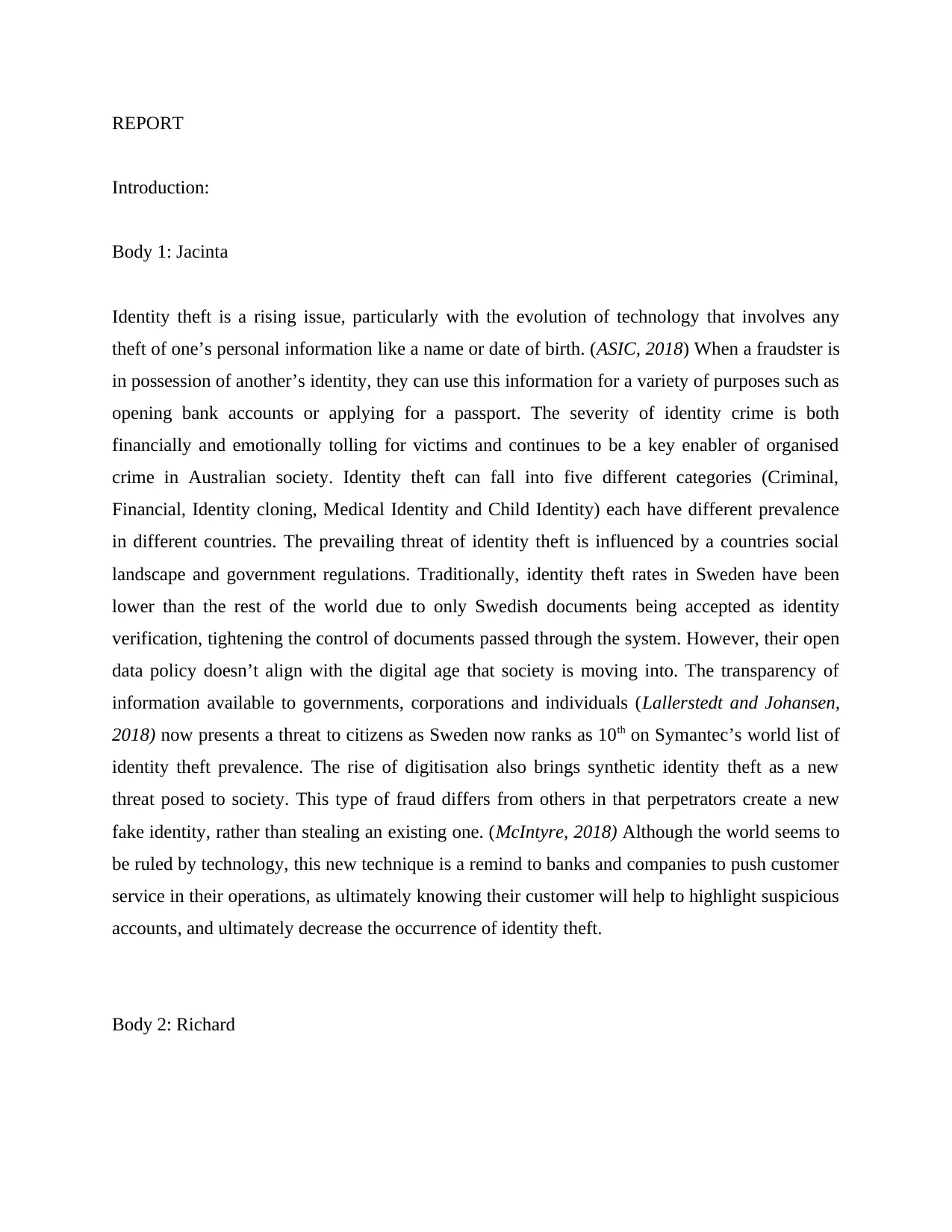
REPORT
Introduction:
Body 1: Jacinta
Identity theft is a rising issue, particularly with the evolution of technology that involves any
theft of one’s personal information like a name or date of birth. (ASIC, 2018) When a fraudster is
in possession of another’s identity, they can use this information for a variety of purposes such as
opening bank accounts or applying for a passport. The severity of identity crime is both
financially and emotionally tolling for victims and continues to be a key enabler of organised
crime in Australian society. Identity theft can fall into five different categories (Criminal,
Financial, Identity cloning, Medical Identity and Child Identity) each have different prevalence
in different countries. The prevailing threat of identity theft is influenced by a countries social
landscape and government regulations. Traditionally, identity theft rates in Sweden have been
lower than the rest of the world due to only Swedish documents being accepted as identity
verification, tightening the control of documents passed through the system. However, their open
data policy doesn’t align with the digital age that society is moving into. The transparency of
information available to governments, corporations and individuals (Lallerstedt and Johansen,
2018) now presents a threat to citizens as Sweden now ranks as 10th on Symantec’s world list of
identity theft prevalence. The rise of digitisation also brings synthetic identity theft as a new
threat posed to society. This type of fraud differs from others in that perpetrators create a new
fake identity, rather than stealing an existing one. (McIntyre, 2018) Although the world seems to
be ruled by technology, this new technique is a remind to banks and companies to push customer
service in their operations, as ultimately knowing their customer will help to highlight suspicious
accounts, and ultimately decrease the occurrence of identity theft.
Body 2: Richard
Introduction:
Body 1: Jacinta
Identity theft is a rising issue, particularly with the evolution of technology that involves any
theft of one’s personal information like a name or date of birth. (ASIC, 2018) When a fraudster is
in possession of another’s identity, they can use this information for a variety of purposes such as
opening bank accounts or applying for a passport. The severity of identity crime is both
financially and emotionally tolling for victims and continues to be a key enabler of organised
crime in Australian society. Identity theft can fall into five different categories (Criminal,
Financial, Identity cloning, Medical Identity and Child Identity) each have different prevalence
in different countries. The prevailing threat of identity theft is influenced by a countries social
landscape and government regulations. Traditionally, identity theft rates in Sweden have been
lower than the rest of the world due to only Swedish documents being accepted as identity
verification, tightening the control of documents passed through the system. However, their open
data policy doesn’t align with the digital age that society is moving into. The transparency of
information available to governments, corporations and individuals (Lallerstedt and Johansen,
2018) now presents a threat to citizens as Sweden now ranks as 10th on Symantec’s world list of
identity theft prevalence. The rise of digitisation also brings synthetic identity theft as a new
threat posed to society. This type of fraud differs from others in that perpetrators create a new
fake identity, rather than stealing an existing one. (McIntyre, 2018) Although the world seems to
be ruled by technology, this new technique is a remind to banks and companies to push customer
service in their operations, as ultimately knowing their customer will help to highlight suspicious
accounts, and ultimately decrease the occurrence of identity theft.
Body 2: Richard
Paraphrase This Document
Need a fresh take? Get an instant paraphrase of this document with our AI Paraphraser
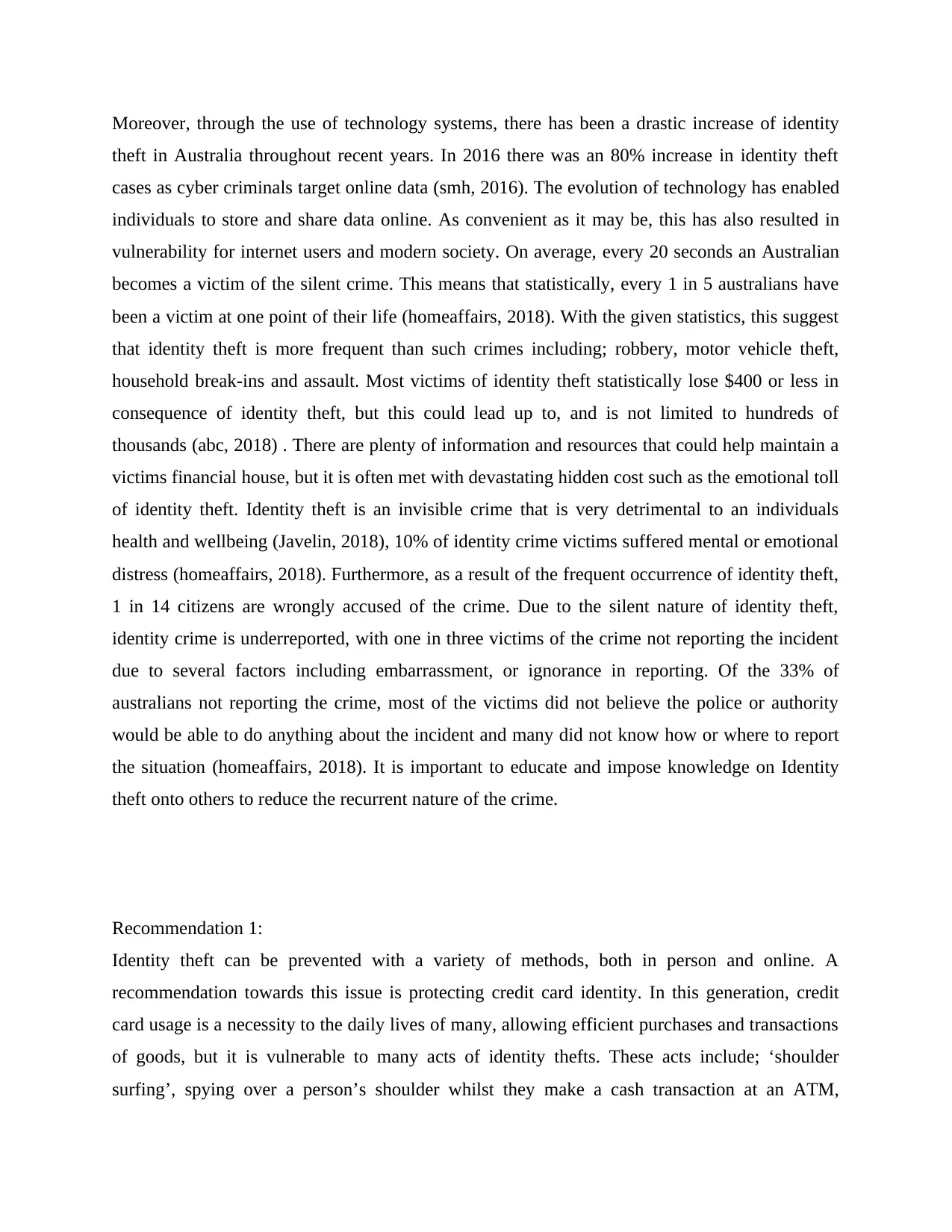
Moreover, through the use of technology systems, there has been a drastic increase of identity
theft in Australia throughout recent years. In 2016 there was an 80% increase in identity theft
cases as cyber criminals target online data (smh, 2016). The evolution of technology has enabled
individuals to store and share data online. As convenient as it may be, this has also resulted in
vulnerability for internet users and modern society. On average, every 20 seconds an Australian
becomes a victim of the silent crime. This means that statistically, every 1 in 5 australians have
been a victim at one point of their life (homeaffairs, 2018). With the given statistics, this suggest
that identity theft is more frequent than such crimes including; robbery, motor vehicle theft,
household break-ins and assault. Most victims of identity theft statistically lose $400 or less in
consequence of identity theft, but this could lead up to, and is not limited to hundreds of
thousands (abc, 2018) . There are plenty of information and resources that could help maintain a
victims financial house, but it is often met with devastating hidden cost such as the emotional toll
of identity theft. Identity theft is an invisible crime that is very detrimental to an individuals
health and wellbeing (Javelin, 2018), 10% of identity crime victims suffered mental or emotional
distress (homeaffairs, 2018). Furthermore, as a result of the frequent occurrence of identity theft,
1 in 14 citizens are wrongly accused of the crime. Due to the silent nature of identity theft,
identity crime is underreported, with one in three victims of the crime not reporting the incident
due to several factors including embarrassment, or ignorance in reporting. Of the 33% of
australians not reporting the crime, most of the victims did not believe the police or authority
would be able to do anything about the incident and many did not know how or where to report
the situation (homeaffairs, 2018). It is important to educate and impose knowledge on Identity
theft onto others to reduce the recurrent nature of the crime.
Recommendation 1:
Identity theft can be prevented with a variety of methods, both in person and online. A
recommendation towards this issue is protecting credit card identity. In this generation, credit
card usage is a necessity to the daily lives of many, allowing efficient purchases and transactions
of goods, but it is vulnerable to many acts of identity thefts. These acts include; ‘shoulder
surfing’, spying over a person’s shoulder whilst they make a cash transaction at an ATM,
theft in Australia throughout recent years. In 2016 there was an 80% increase in identity theft
cases as cyber criminals target online data (smh, 2016). The evolution of technology has enabled
individuals to store and share data online. As convenient as it may be, this has also resulted in
vulnerability for internet users and modern society. On average, every 20 seconds an Australian
becomes a victim of the silent crime. This means that statistically, every 1 in 5 australians have
been a victim at one point of their life (homeaffairs, 2018). With the given statistics, this suggest
that identity theft is more frequent than such crimes including; robbery, motor vehicle theft,
household break-ins and assault. Most victims of identity theft statistically lose $400 or less in
consequence of identity theft, but this could lead up to, and is not limited to hundreds of
thousands (abc, 2018) . There are plenty of information and resources that could help maintain a
victims financial house, but it is often met with devastating hidden cost such as the emotional toll
of identity theft. Identity theft is an invisible crime that is very detrimental to an individuals
health and wellbeing (Javelin, 2018), 10% of identity crime victims suffered mental or emotional
distress (homeaffairs, 2018). Furthermore, as a result of the frequent occurrence of identity theft,
1 in 14 citizens are wrongly accused of the crime. Due to the silent nature of identity theft,
identity crime is underreported, with one in three victims of the crime not reporting the incident
due to several factors including embarrassment, or ignorance in reporting. Of the 33% of
australians not reporting the crime, most of the victims did not believe the police or authority
would be able to do anything about the incident and many did not know how or where to report
the situation (homeaffairs, 2018). It is important to educate and impose knowledge on Identity
theft onto others to reduce the recurrent nature of the crime.
Recommendation 1:
Identity theft can be prevented with a variety of methods, both in person and online. A
recommendation towards this issue is protecting credit card identity. In this generation, credit
card usage is a necessity to the daily lives of many, allowing efficient purchases and transactions
of goods, but it is vulnerable to many acts of identity thefts. These acts include; ‘shoulder
surfing’, spying over a person’s shoulder whilst they make a cash transaction at an ATM,
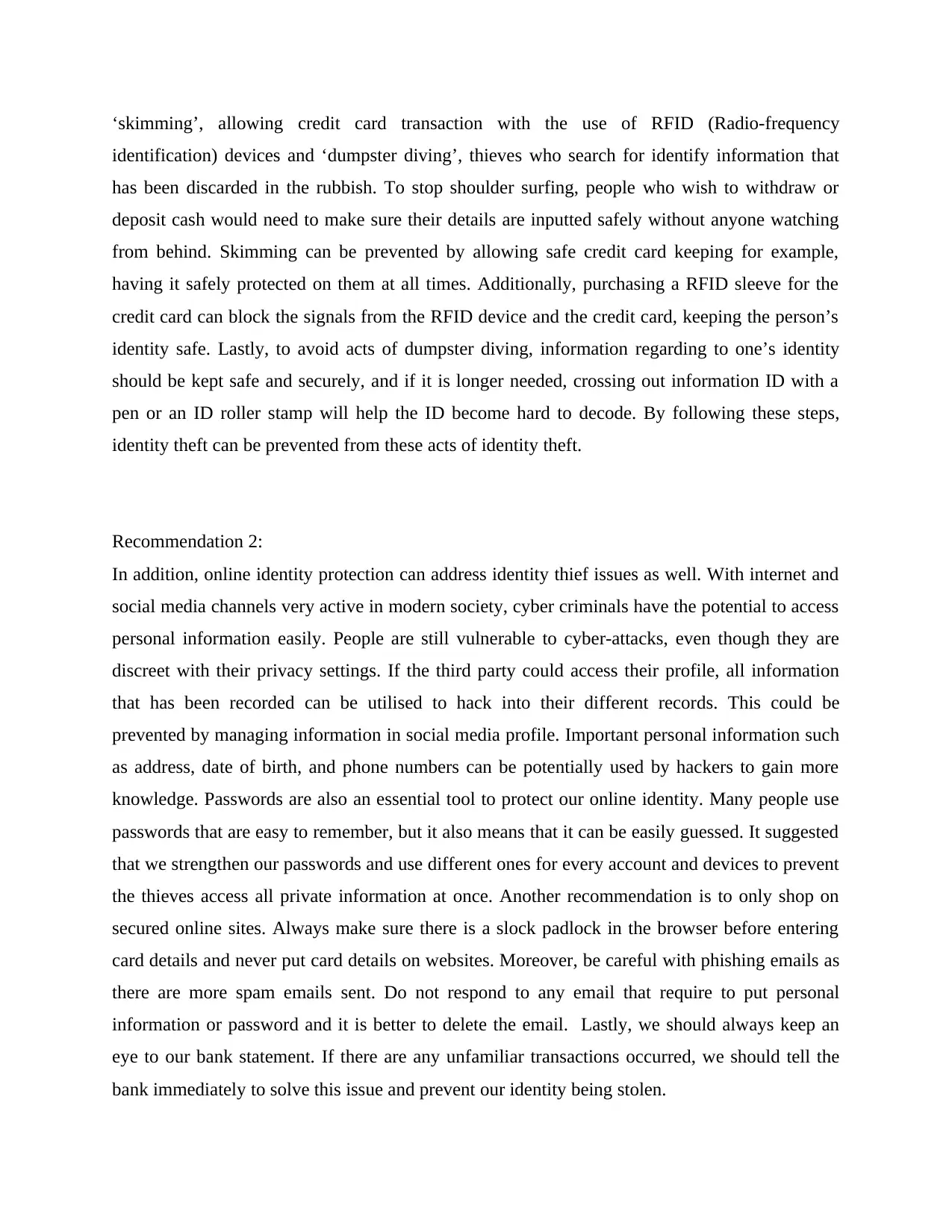
‘skimming’, allowing credit card transaction with the use of RFID (Radio-frequency
identification) devices and ‘dumpster diving’, thieves who search for identify information that
has been discarded in the rubbish. To stop shoulder surfing, people who wish to withdraw or
deposit cash would need to make sure their details are inputted safely without anyone watching
from behind. Skimming can be prevented by allowing safe credit card keeping for example,
having it safely protected on them at all times. Additionally, purchasing a RFID sleeve for the
credit card can block the signals from the RFID device and the credit card, keeping the person’s
identity safe. Lastly, to avoid acts of dumpster diving, information regarding to one’s identity
should be kept safe and securely, and if it is longer needed, crossing out information ID with a
pen or an ID roller stamp will help the ID become hard to decode. By following these steps,
identity theft can be prevented from these acts of identity theft.
Recommendation 2:
In addition, online identity protection can address identity thief issues as well. With internet and
social media channels very active in modern society, cyber criminals have the potential to access
personal information easily. People are still vulnerable to cyber-attacks, even though they are
discreet with their privacy settings. If the third party could access their profile, all information
that has been recorded can be utilised to hack into their different records. This could be
prevented by managing information in social media profile. Important personal information such
as address, date of birth, and phone numbers can be potentially used by hackers to gain more
knowledge. Passwords are also an essential tool to protect our online identity. Many people use
passwords that are easy to remember, but it also means that it can be easily guessed. It suggested
that we strengthen our passwords and use different ones for every account and devices to prevent
the thieves access all private information at once. Another recommendation is to only shop on
secured online sites. Always make sure there is a slock padlock in the browser before entering
card details and never put card details on websites. Moreover, be careful with phishing emails as
there are more spam emails sent. Do not respond to any email that require to put personal
information or password and it is better to delete the email. Lastly, we should always keep an
eye to our bank statement. If there are any unfamiliar transactions occurred, we should tell the
bank immediately to solve this issue and prevent our identity being stolen.
identification) devices and ‘dumpster diving’, thieves who search for identify information that
has been discarded in the rubbish. To stop shoulder surfing, people who wish to withdraw or
deposit cash would need to make sure their details are inputted safely without anyone watching
from behind. Skimming can be prevented by allowing safe credit card keeping for example,
having it safely protected on them at all times. Additionally, purchasing a RFID sleeve for the
credit card can block the signals from the RFID device and the credit card, keeping the person’s
identity safe. Lastly, to avoid acts of dumpster diving, information regarding to one’s identity
should be kept safe and securely, and if it is longer needed, crossing out information ID with a
pen or an ID roller stamp will help the ID become hard to decode. By following these steps,
identity theft can be prevented from these acts of identity theft.
Recommendation 2:
In addition, online identity protection can address identity thief issues as well. With internet and
social media channels very active in modern society, cyber criminals have the potential to access
personal information easily. People are still vulnerable to cyber-attacks, even though they are
discreet with their privacy settings. If the third party could access their profile, all information
that has been recorded can be utilised to hack into their different records. This could be
prevented by managing information in social media profile. Important personal information such
as address, date of birth, and phone numbers can be potentially used by hackers to gain more
knowledge. Passwords are also an essential tool to protect our online identity. Many people use
passwords that are easy to remember, but it also means that it can be easily guessed. It suggested
that we strengthen our passwords and use different ones for every account and devices to prevent
the thieves access all private information at once. Another recommendation is to only shop on
secured online sites. Always make sure there is a slock padlock in the browser before entering
card details and never put card details on websites. Moreover, be careful with phishing emails as
there are more spam emails sent. Do not respond to any email that require to put personal
information or password and it is better to delete the email. Lastly, we should always keep an
eye to our bank statement. If there are any unfamiliar transactions occurred, we should tell the
bank immediately to solve this issue and prevent our identity being stolen.
⊘ This is a preview!⊘
Do you want full access?
Subscribe today to unlock all pages.

Trusted by 1+ million students worldwide
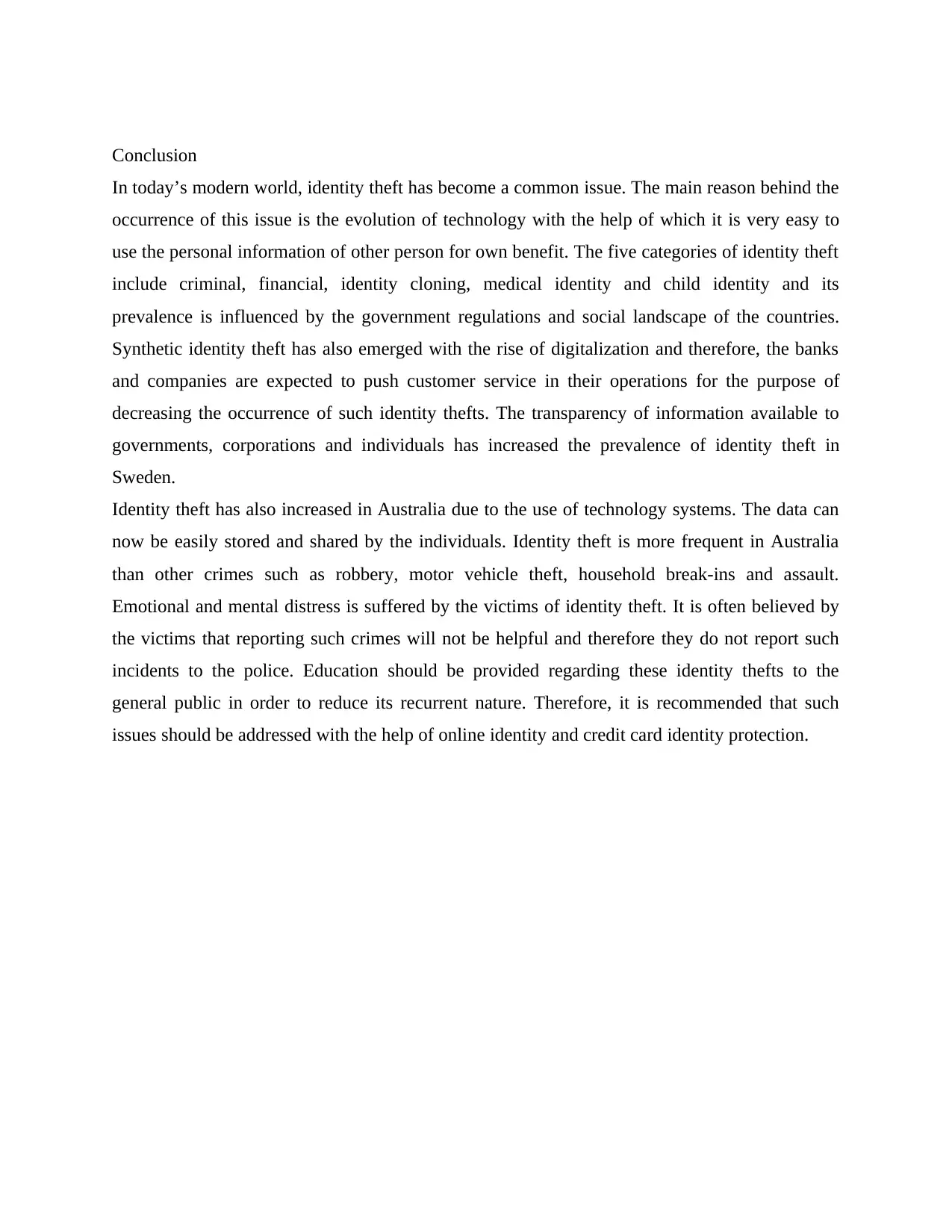
Conclusion
In today’s modern world, identity theft has become a common issue. The main reason behind the
occurrence of this issue is the evolution of technology with the help of which it is very easy to
use the personal information of other person for own benefit. The five categories of identity theft
include criminal, financial, identity cloning, medical identity and child identity and its
prevalence is influenced by the government regulations and social landscape of the countries.
Synthetic identity theft has also emerged with the rise of digitalization and therefore, the banks
and companies are expected to push customer service in their operations for the purpose of
decreasing the occurrence of such identity thefts. The transparency of information available to
governments, corporations and individuals has increased the prevalence of identity theft in
Sweden.
Identity theft has also increased in Australia due to the use of technology systems. The data can
now be easily stored and shared by the individuals. Identity theft is more frequent in Australia
than other crimes such as robbery, motor vehicle theft, household break-ins and assault.
Emotional and mental distress is suffered by the victims of identity theft. It is often believed by
the victims that reporting such crimes will not be helpful and therefore they do not report such
incidents to the police. Education should be provided regarding these identity thefts to the
general public in order to reduce its recurrent nature. Therefore, it is recommended that such
issues should be addressed with the help of online identity and credit card identity protection.
In today’s modern world, identity theft has become a common issue. The main reason behind the
occurrence of this issue is the evolution of technology with the help of which it is very easy to
use the personal information of other person for own benefit. The five categories of identity theft
include criminal, financial, identity cloning, medical identity and child identity and its
prevalence is influenced by the government regulations and social landscape of the countries.
Synthetic identity theft has also emerged with the rise of digitalization and therefore, the banks
and companies are expected to push customer service in their operations for the purpose of
decreasing the occurrence of such identity thefts. The transparency of information available to
governments, corporations and individuals has increased the prevalence of identity theft in
Sweden.
Identity theft has also increased in Australia due to the use of technology systems. The data can
now be easily stored and shared by the individuals. Identity theft is more frequent in Australia
than other crimes such as robbery, motor vehicle theft, household break-ins and assault.
Emotional and mental distress is suffered by the victims of identity theft. It is often believed by
the victims that reporting such crimes will not be helpful and therefore they do not report such
incidents to the police. Education should be provided regarding these identity thefts to the
general public in order to reduce its recurrent nature. Therefore, it is recommended that such
issues should be addressed with the help of online identity and credit card identity protection.
Paraphrase This Document
Need a fresh take? Get an instant paraphrase of this document with our AI Paraphraser
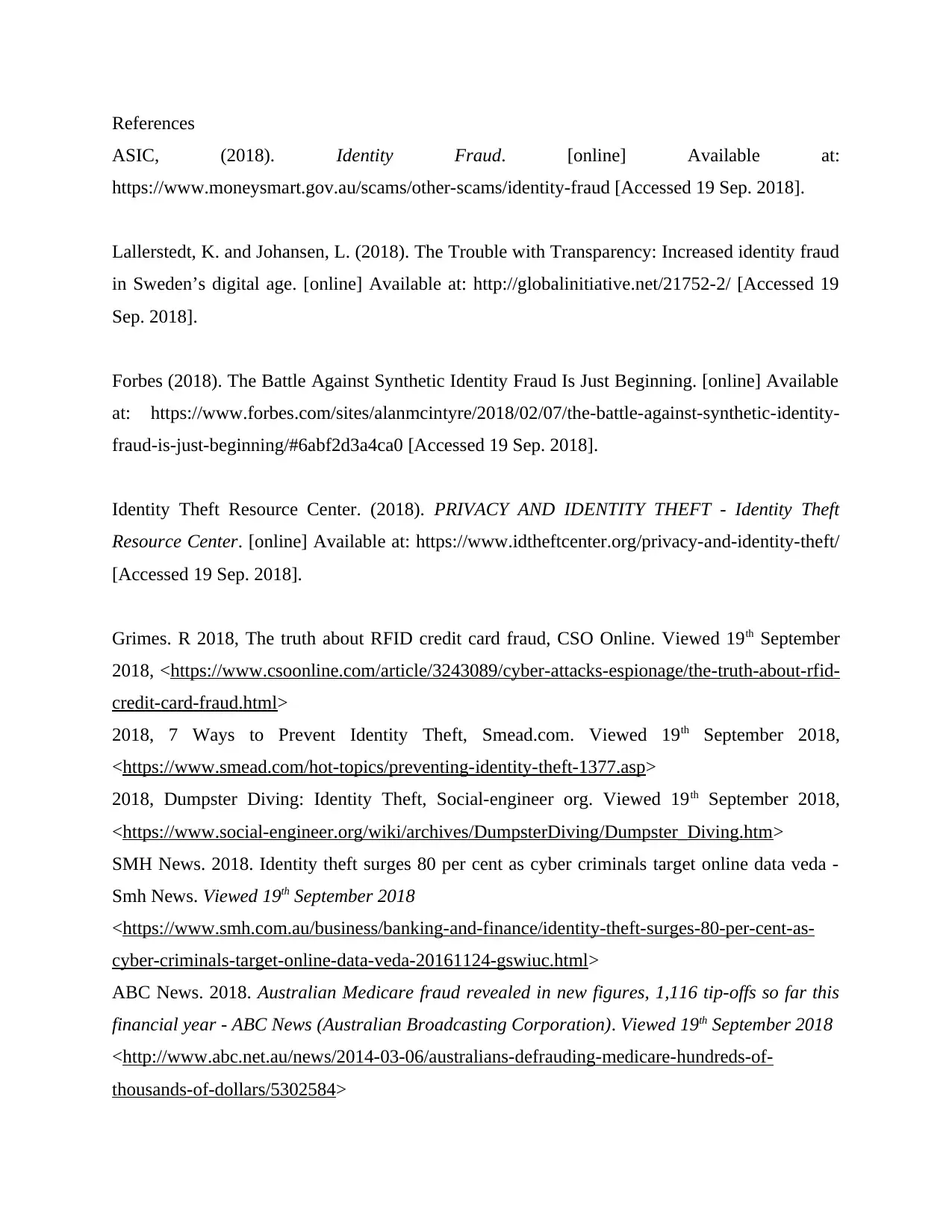
References
ASIC, (2018). Identity Fraud. [online] Available at:
https://www.moneysmart.gov.au/scams/other-scams/identity-fraud [Accessed 19 Sep. 2018].
Lallerstedt, K. and Johansen, L. (2018). The Trouble with Transparency: Increased identity fraud
in Sweden’s digital age. [online] Available at: http://globalinitiative.net/21752-2/ [Accessed 19
Sep. 2018].
Forbes (2018). The Battle Against Synthetic Identity Fraud Is Just Beginning. [online] Available
at: https://www.forbes.com/sites/alanmcintyre/2018/02/07/the-battle-against-synthetic-identity-
fraud-is-just-beginning/#6abf2d3a4ca0 [Accessed 19 Sep. 2018].
Identity Theft Resource Center. (2018). PRIVACY AND IDENTITY THEFT - Identity Theft
Resource Center. [online] Available at: https://www.idtheftcenter.org/privacy-and-identity-theft/
[Accessed 19 Sep. 2018].
Grimes. R 2018, The truth about RFID credit card fraud, CSO Online. Viewed 19th September
2018, <https://www.csoonline.com/article/3243089/cyber-attacks-espionage/the-truth-about-rfid-
credit-card-fraud.html>
2018, 7 Ways to Prevent Identity Theft, Smead.com. Viewed 19th September 2018,
<https://www.smead.com/hot-topics/preventing-identity-theft-1377.asp>
2018, Dumpster Diving: Identity Theft, Social-engineer org. Viewed 19th September 2018,
<https://www.social-engineer.org/wiki/archives/DumpsterDiving/Dumpster_Diving.htm>
SMH News. 2018. Identity theft surges 80 per cent as cyber criminals target online data veda -
Smh News. Viewed 19th September 2018
<https://www.smh.com.au/business/banking-and-finance/identity-theft-surges-80-per-cent-as-
cyber-criminals-target-online-data-veda-20161124-gswiuc.html>
ABC News. 2018. Australian Medicare fraud revealed in new figures, 1,116 tip-offs so far this
financial year - ABC News (Australian Broadcasting Corporation). Viewed 19th September 2018
<http://www.abc.net.au/news/2014-03-06/australians-defrauding-medicare-hundreds-of-
thousands-of-dollars/5302584>
ASIC, (2018). Identity Fraud. [online] Available at:
https://www.moneysmart.gov.au/scams/other-scams/identity-fraud [Accessed 19 Sep. 2018].
Lallerstedt, K. and Johansen, L. (2018). The Trouble with Transparency: Increased identity fraud
in Sweden’s digital age. [online] Available at: http://globalinitiative.net/21752-2/ [Accessed 19
Sep. 2018].
Forbes (2018). The Battle Against Synthetic Identity Fraud Is Just Beginning. [online] Available
at: https://www.forbes.com/sites/alanmcintyre/2018/02/07/the-battle-against-synthetic-identity-
fraud-is-just-beginning/#6abf2d3a4ca0 [Accessed 19 Sep. 2018].
Identity Theft Resource Center. (2018). PRIVACY AND IDENTITY THEFT - Identity Theft
Resource Center. [online] Available at: https://www.idtheftcenter.org/privacy-and-identity-theft/
[Accessed 19 Sep. 2018].
Grimes. R 2018, The truth about RFID credit card fraud, CSO Online. Viewed 19th September
2018, <https://www.csoonline.com/article/3243089/cyber-attacks-espionage/the-truth-about-rfid-
credit-card-fraud.html>
2018, 7 Ways to Prevent Identity Theft, Smead.com. Viewed 19th September 2018,
<https://www.smead.com/hot-topics/preventing-identity-theft-1377.asp>
2018, Dumpster Diving: Identity Theft, Social-engineer org. Viewed 19th September 2018,
<https://www.social-engineer.org/wiki/archives/DumpsterDiving/Dumpster_Diving.htm>
SMH News. 2018. Identity theft surges 80 per cent as cyber criminals target online data veda -
Smh News. Viewed 19th September 2018
<https://www.smh.com.au/business/banking-and-finance/identity-theft-surges-80-per-cent-as-
cyber-criminals-target-online-data-veda-20161124-gswiuc.html>
ABC News. 2018. Australian Medicare fraud revealed in new figures, 1,116 tip-offs so far this
financial year - ABC News (Australian Broadcasting Corporation). Viewed 19th September 2018
<http://www.abc.net.au/news/2014-03-06/australians-defrauding-medicare-hundreds-of-
thousands-of-dollars/5302584>
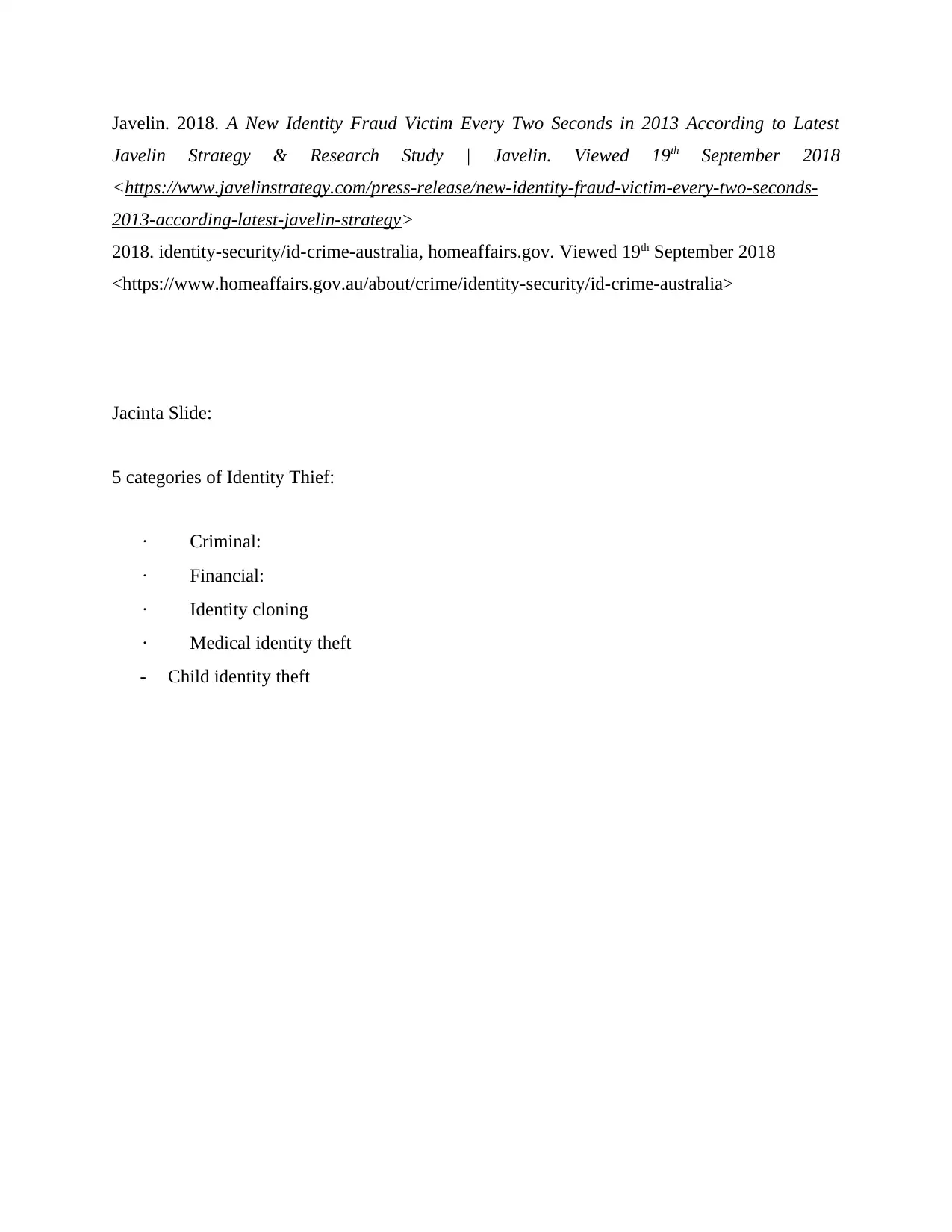
Javelin. 2018. A New Identity Fraud Victim Every Two Seconds in 2013 According to Latest
Javelin Strategy & Research Study | Javelin. Viewed 19th September 2018
<https://www.javelinstrategy.com/press-release/new-identity-fraud-victim-every-two-seconds-
2013-according-latest-javelin-strategy>
2018. identity-security/id-crime-australia, homeaffairs.gov. Viewed 19th September 2018
<https://www.homeaffairs.gov.au/about/crime/identity-security/id-crime-australia>
Jacinta Slide:
5 categories of Identity Thief:
· Criminal:
· Financial:
· Identity cloning
· Medical identity theft
- Child identity theft
Javelin Strategy & Research Study | Javelin. Viewed 19th September 2018
<https://www.javelinstrategy.com/press-release/new-identity-fraud-victim-every-two-seconds-
2013-according-latest-javelin-strategy>
2018. identity-security/id-crime-australia, homeaffairs.gov. Viewed 19th September 2018
<https://www.homeaffairs.gov.au/about/crime/identity-security/id-crime-australia>
Jacinta Slide:
5 categories of Identity Thief:
· Criminal:
· Financial:
· Identity cloning
· Medical identity theft
- Child identity theft
⊘ This is a preview!⊘
Do you want full access?
Subscribe today to unlock all pages.

Trusted by 1+ million students worldwide
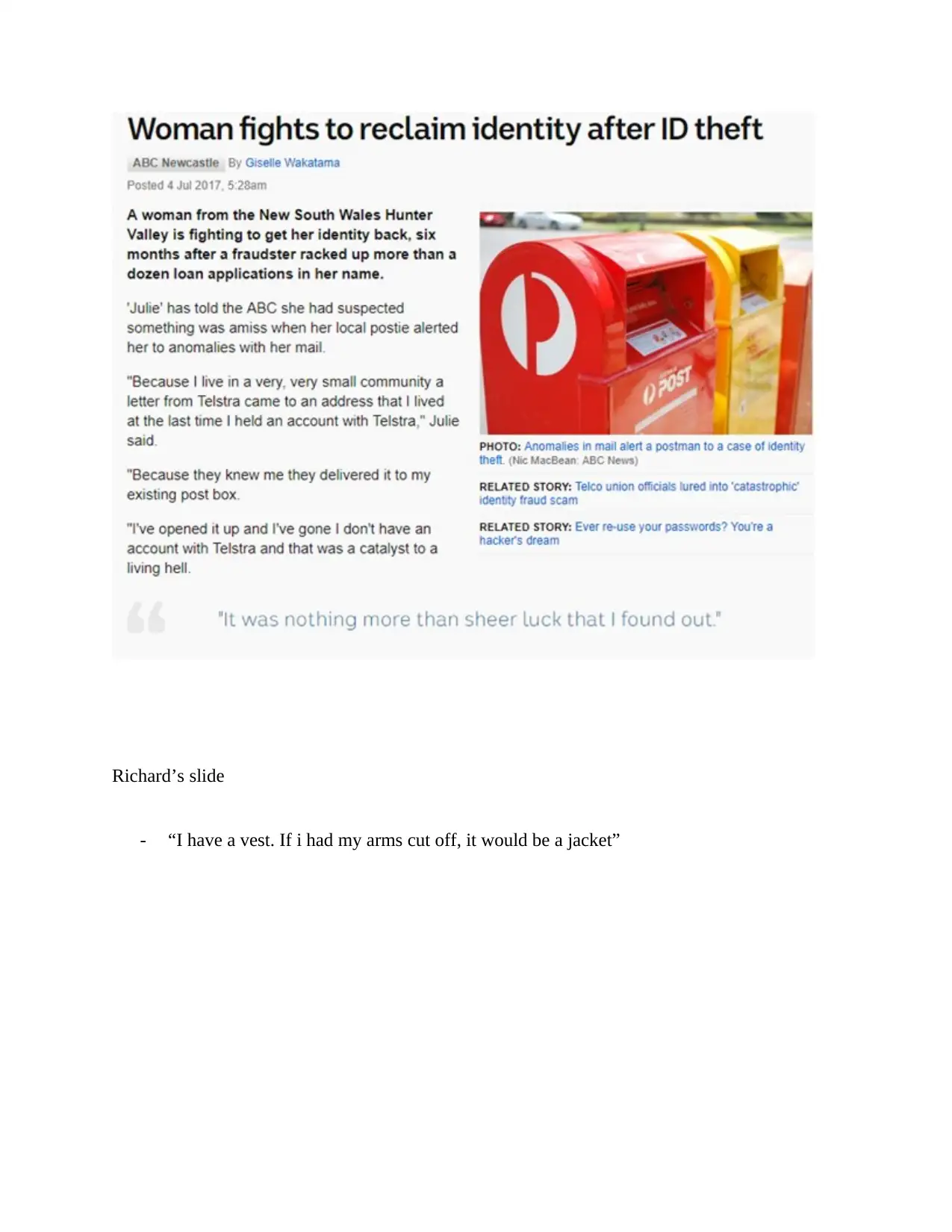
Richard’s slide
- “I have a vest. If i had my arms cut off, it would be a jacket”
- “I have a vest. If i had my arms cut off, it would be a jacket”
1 out of 7
Related Documents
Your All-in-One AI-Powered Toolkit for Academic Success.
+13062052269
info@desklib.com
Available 24*7 on WhatsApp / Email
![[object Object]](/_next/static/media/star-bottom.7253800d.svg)
Unlock your academic potential
Copyright © 2020–2025 A2Z Services. All Rights Reserved. Developed and managed by ZUCOL.





